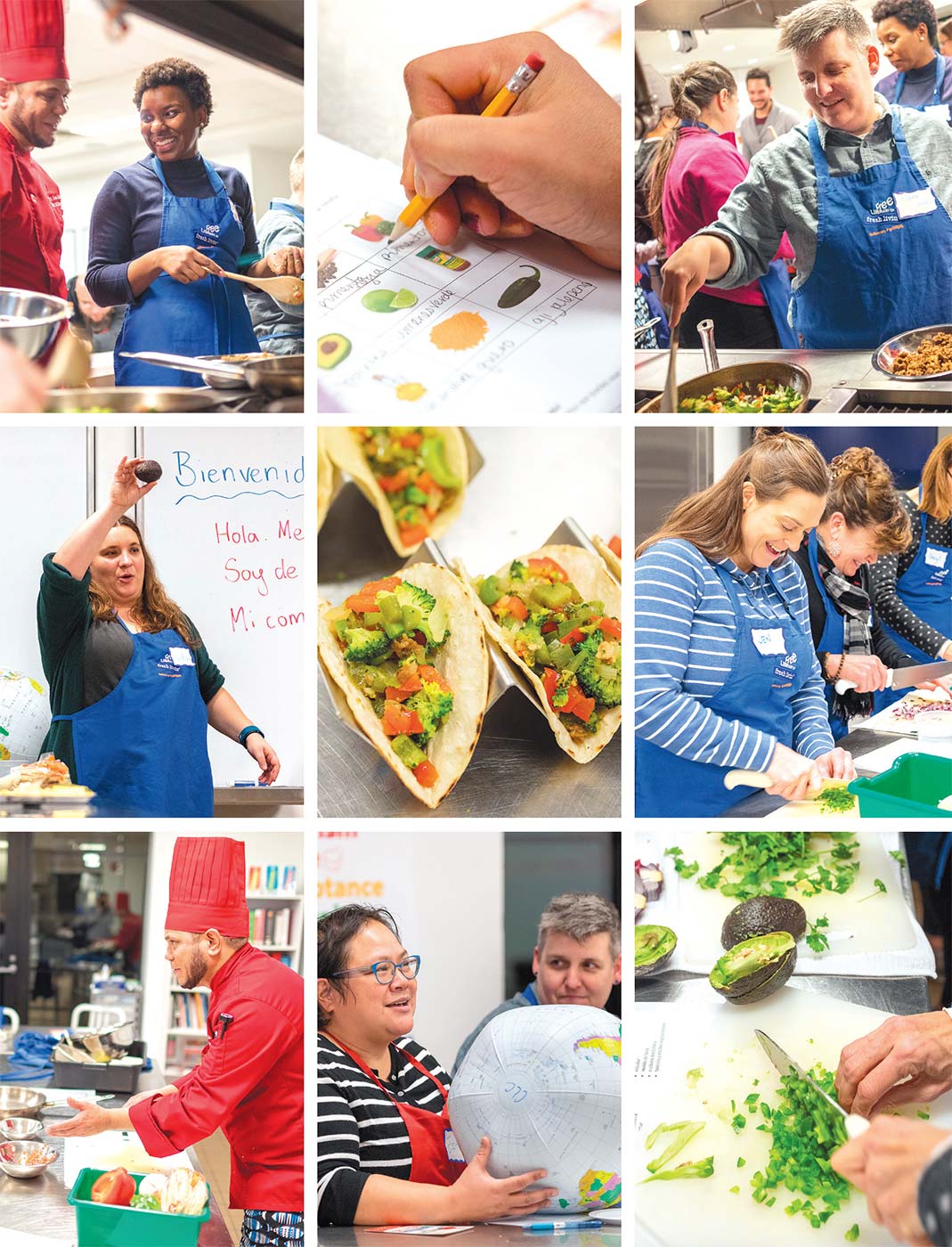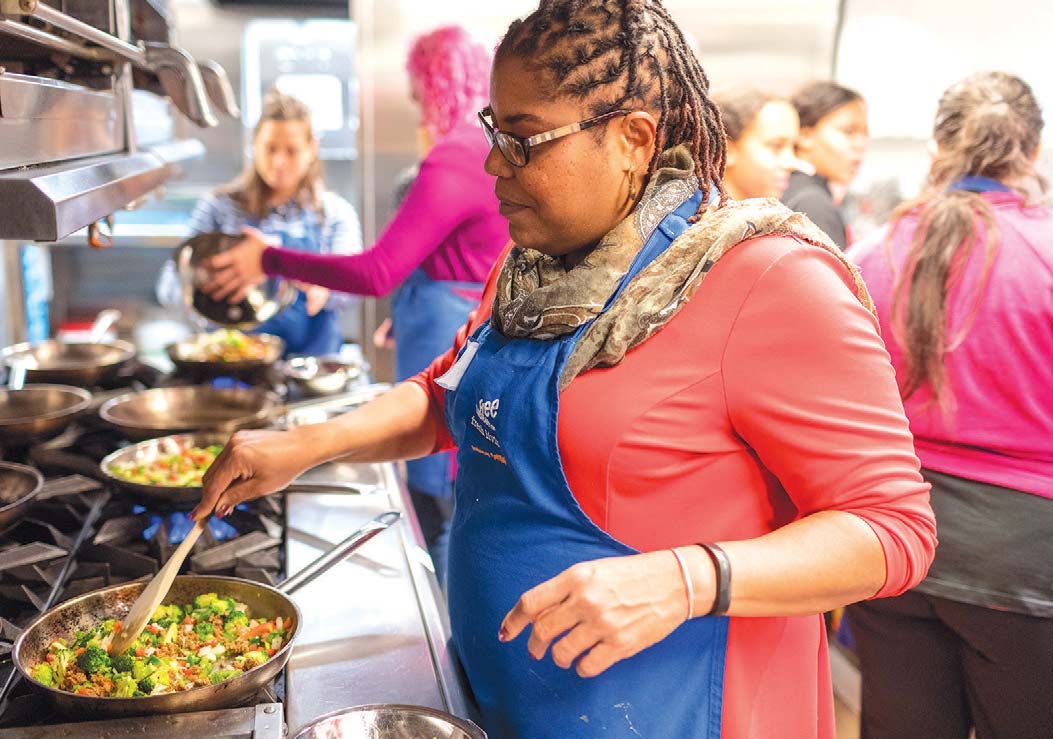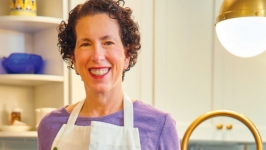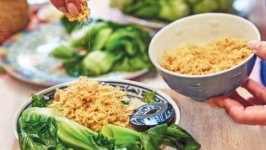Learning a New Language through Food at Philadelphia's Free Library
SINCE 2014, THE FREE LIBRARY OF PHILADELPHIA’S Culinary Literacy Center has been a hotspot for innovative food education. Every month’s roster of classes is rooted in the center’s mission to advance literacy through food.
In some cases, that’s literal. Since 2015, the Edible Alphabet program has welcomed English language learners, including immigrants and refugees, to the library’s kitchen classroom for free six- to eight-week courses that blend culinary and language lessons. People from around the world prepare a shared meal, led by both English and cooking instructors. Along the way, they expand their reading, writing and speaking skills in a low-pressure setting where recipes become a key to unlocking language.
According to program manager Lindsay Southworth, Edible Alphabet’s goals are threefold: to build language skills, to connect English language learners with library resources and to create a welcoming community that integrates students into the cultural and civic life of Philadelphia.
“Fun English cooking classes are a great way to get people in the door, and the libraries are an institution that belongs to everyone,” Southworth says. “The cooking component really helps to quickly build that warm, inclusive community where people are having fun and connecting.”
To date, more than 600 students from 50-plus countries have participated in Edible Alphabet classes. This led to an idea: Could the concept be replicated for English speakers? In 2018, the library tested this idea with a Spanish class meant for English-speaking students.
The expanded series now includes single fee-based sessions for English speakers that highlight global languages and cuisines. (Free spaces for SNAP-eligible participants can be reserved.) Each of these one-class programs offers a taste of a new language. The experience is more than a way to learn Spanish vocab or gain dumpling-folding skills. Funds raised from the paid classes support the core Edible Alphabet program. This makes a fun night out an easy way to help others learn English.

Jiaozi and Restaurant-Ready Mandarin
On a Tuesday in September, hungry students filtered into the library’s bright culinary classroom. Atop steel worktables, bowls of cucumber salad dressed with sesame oil offered a hint of what would unfold—or fold. Co-teachers La Sripanawongsa, a Friends Select School instructor, and David Dettman, associate director of the University of Pennsylvania’s Center for East Asian Studies, were kicking off the library’s inaugural Edible Alphabet in Mandarin class, centered on a recipe for dumplings.
Beginning the culinary lesson, Dettman offered an overview of China’s eight great cuisines, of which Sichuan, Hunan, and Cantonese are most common in the States. Dumplings (jiaozi) hail from the north, where a cool climate supports wheat.
While we learned basic information about the cuisine, language exercises got people speaking. “ZH is basically the same as a J. SH is basically the same as X,” Dettman explained. “But you use ZH at the front of your mouth and SH at the back.”
We followed his lead, rolling syllables back and forth. Sripanawongsa then offered restaurant-ready vocabulary of equal value in Chinatown or on an international trip. Food, she explained, is so central to Chinese culture that nĭ chī le ma (“Have you eaten?) is a common Chinese greeting, akin to “how’s it going” in English.
Given that, it’s important to know the proper response: “Chī le!” (I ate!)
Appetites stoked, it was time to prepare the dumplings, an activity ideally suited to a boisterous group. Given the labor involved, family traditionally gathers to make them, Sripanawongsa noted. We translated ingredients as we measured and chopped: Black vinegar (cu), scallions (cōng), ginger (jiāng).
Then came the life-changing portion of the evening: Sripanawongsa’s demo of four folding techniques, from simply sealed to intricately pleated. For an avid home cook, that intel was fēichéng hăo (extremely good) by all accounts.
Gli Ingredienti for Elementary Italian
Several weeks later, a new group arrived in the kitchen to the sound of crooning Sinatra tunes. Pasta machines gleamed in a corner. As we nibbled bruschetta, Italian instructor Julia D’Aleandro Meyers circulated a wooden-spoon microphone, tasking us with Italian introductions:
Mi chiamo Jenn.
Sono di New Jersey.
Il mio piatto preferito è . . . tutto.
(My name is Jenn. I’m from New Jersey. My favorite dish is . . . everything.)
“Cooking is all about fun and creating a community,” mused chef Gregorio Fierro, who began the culinary portion of the class with an abridged history of Italian pasta. The power of culinary connections is something the Naples-born chef and restaurant consultant understands well. Several times a year, he lends his expertise during small group culinary tours to southern Italy via Betsy Spivak’s company, Travel with a Local.
Fierro explained the flour types suited to fresh pasta, answering a flurry of questions as Spivak served more bruschetta. “We probably wouldn’t exist as a species if it wasn’t for wheat,” said Fierro—and while his favorite flour is not sold retail in the U.S., he explained that a mix of all-purpose and durum is the next best thing.
As in the Mandarin class, we embarked on a hands-on translation of the evening’s recipe, this time for tagliatelle al pesto. Farina (flour) was poured in mounds on tabletops. Uova and sale (eggs and salt) were added to center wells. Then gently, gently, we formed the dough, Fierro making rounds and then guiding us to the macchina per la pasta (pasta machine).
Back at the tables, we eyed our pasta- in-progress and worked through restaurant dialogue, each person taking on a role: Buena sera, signori. Grazie mille.
Finally, chef Fierro showed us how to make pesto, sprinkling the presentation with tips. Skip the pine nuts (pinole) in favor of unsalted cashews, which are less expensive. Use everyday olive oil (olio d’oliva) instead of the good stuff. Loosen pesto with pasta cooking water. “Without it, the pesto will just sit in the dish,” Fierro explained.
By night’s end, classmates were laughing over steaming bowls of pasta, with plans for a repeat course simmering.
Comfort in the kitchen and willingness to take risks translates to people taking risks with the language. Humans learn by doing, and sharing food is integral to every culture.
New Languages on Deck
Heading into 2020, the library expects to add additional Edible Alphabet classes, including a course in Arabic and hopefully one in French. (If you or a contact have francophone cooking or teaching skills, reach out!) As Edible Alphabet instructor David Dettman says, “Enjoying food is universal, and it’s an easy way to begin interacting with a new culture.
In keeping with its mission, the library is also sharing its recipe for culinary language learning. The course for English language learners has been so well received, it is being replicated in cities around the country, including Boston, Brooklyn and Athens, GA. Local religious organizations and other groups interested in launching courses are welcome to the curriculum.
There’s a reason it works, Southworth says: Comfort in the kitchen and willingness to take risks translates to people taking risks with the language. Humans learn by doing, and sharing food is integral to every culture.
“Food is often the first aspect of a foreign culture that we embrace. Learning the intricacies of foods helps us develop an understanding of traditions, climates and beliefs of a place, and [is] often the catalyst for us to explore those things more deeply,” Fierro notes. Sripanawongsa concurs. “As a language teacher, I always look forward to teaching my students about food, cooking and eating in the language. It’s all about bringing people together.”
Learn Language Through Food!
Cook across languages:
“Find a friend who is a native speaker of another language and do a cooking-language exchange. One week, do apple pie in English. Then the next week, make empanadas in Spanish.” —Lindsay Southworth, Program Manager, Free Library of Philadelphia
Attend YouTube University:
“Watch cooking shows in the language you’re learning. You can find people cooking in their homes and hear the language.” —Betsy Spivak, Travel with a Local
Prep before a meal:
“Italian is a phonetic language. Once you learn how the vowels sound, you can pretty much say anything that’s written.” —Gregorio Fierro, chef and cooking instructor
Bring vocab to dinner:
“Visit your favorite Chinese restaurant. Ask for the names of dishes in Chinese, and how to say ‘delicious.’ Next time you go, order in Chinese and give compliments to the chef! It might not be perfect, but you’ll certainly get a big smile.” —La Sripanawongsa, Mandarin teacher, Friends Select
Travel with an appetite:
“When you travel, take a cooking class in someone’s home. There, you’re getting the real food language” —Betsy Spivak, Travel with a Local










